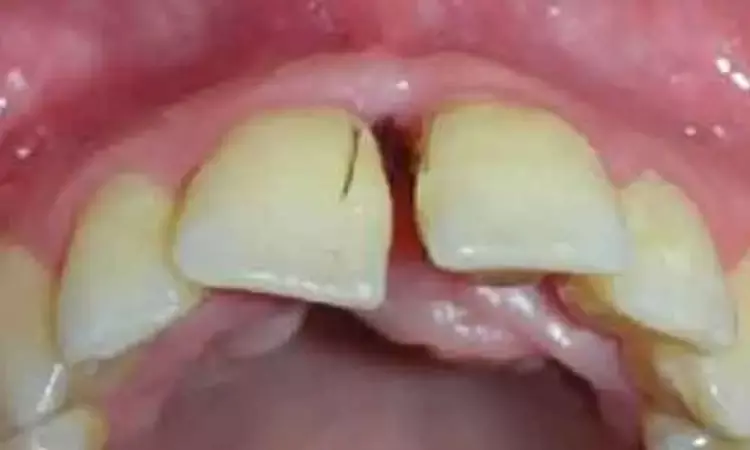- Home
- Medical news & Guidelines
- Anesthesiology
- Cardiology and CTVS
- Critical Care
- Dentistry
- Dermatology
- Diabetes and Endocrinology
- ENT
- Gastroenterology
- Medicine
- Nephrology
- Neurology
- Obstretics-Gynaecology
- Oncology
- Ophthalmology
- Orthopaedics
- Pediatrics-Neonatology
- Psychiatry
- Pulmonology
- Radiology
- Surgery
- Urology
- Laboratory Medicine
- Diet
- Nursing
- Paramedical
- Physiotherapy
- Health news
- Fact Check
- Bone Health Fact Check
- Brain Health Fact Check
- Cancer Related Fact Check
- Child Care Fact Check
- Dental and oral health fact check
- Diabetes and metabolic health fact check
- Diet and Nutrition Fact Check
- Eye and ENT Care Fact Check
- Fitness fact check
- Gut health fact check
- Heart health fact check
- Kidney health fact check
- Medical education fact check
- Men's health fact check
- Respiratory fact check
- Skin and hair care fact check
- Vaccine and Immunization fact check
- Women's health fact check
- AYUSH
- State News
- Andaman and Nicobar Islands
- Andhra Pradesh
- Arunachal Pradesh
- Assam
- Bihar
- Chandigarh
- Chattisgarh
- Dadra and Nagar Haveli
- Daman and Diu
- Delhi
- Goa
- Gujarat
- Haryana
- Himachal Pradesh
- Jammu & Kashmir
- Jharkhand
- Karnataka
- Kerala
- Ladakh
- Lakshadweep
- Madhya Pradesh
- Maharashtra
- Manipur
- Meghalaya
- Mizoram
- Nagaland
- Odisha
- Puducherry
- Punjab
- Rajasthan
- Sikkim
- Tamil Nadu
- Telangana
- Tripura
- Uttar Pradesh
- Uttrakhand
- West Bengal
- Medical Education
- Industry
Gingival bleeding tied to dental shame and verbal bullying among adolescents: Study

Recent research reveals that presence of gingival bleeding negatively impacts the social life of adolescents, causing more episodes of verbal bullying.
The study is published in the Journal of Periodontology.
Previous studies have shown that verbal harassment is the most common form of bullying which affects the health and well‐being of children and adolescents, which can perpetuate into adulthood. The presence of gingival bleeding and edema in the anterior region has been pointed as a determining factor in the decline of oral health self‐perception and oral health‐related quality of life (OHRQoL) in adolescents.
Accordingly, gingival bleeding may be a substantial factor in dental appearance and well‐being of adolescents, and consequently in the occurrence of verbal bullying, because children and adolescents commonly judge the physical aspects between them, which can lead to emotional and social problems. However, no scientific evidence of this association has been evaluated.
Hence, Renita Baldo Moraes and colleagues from the Department of Nursing and Dentistry, University of Santa Cruz do Sul, Santa Cruz do Sul, Rio Grande do Sul, Brazil conducted the present study to assess the association between gingival bleeding and reports of verbal bullying among adolescents.
The authors carried out this cross‐sectional study with a representative sample of 608 12‐year‐old adolescents from southern Brazil. The occurrence of verbal bullying was verified through adolescents' self‐report. Oral health measurements included the presence of gingival bleeding, dental fracture, dental fluorosis, and dental caries experience.
Gingival bleeding was assessed through adolescent self‐perception by the following question: "Did you notice any bleeding in your gums?" Demographic, socioeconomic, and psychosocial variables were also evaluated. Poisson regression models with robust variance were used to evaluate the influence of gingival bleeding on the occurrence of verbal bullying. Results are presented as prevalence ratio (PR) and 95% confidence interval (95% CI).
The results showed that –
- Out of 608 adolescents evaluated, 577 answered bullying questions.
- The prevalence of self‐reported verbal bullying was 12.8%.
- Adolescents who presented gingival bleeding had an 80% higher prevalence of verbal bullying than their counterparts (PR 1.80; 95% CI 1.01 ‐3.19).
- Dental shame, speech difficulties and influence of dental condition on studies also impacted the higher prevalence of bullying.
Therefore, it was concluded that "the presence of gingival bleeding negatively impacts the social life of adolescents, causing more episodes of verbal bullying. These findings encourage public health policies aimed at reducing oral health inequities, thus reflecting on the well‐being and quality of life of this target population."
Dr. Nandita Mohan is a practicing pediatric dentist with more than 5 years of clinical work experience. Along with this, she is equally interested in keeping herself up to date about the latest developments in the field of medicine and dentistry which is the driving force for her to be in association with Medical Dialogues. She also has her name attached with many publications; both national and international. She has pursued her BDS from Rajiv Gandhi University of Health Sciences, Bangalore and later went to enter her dream specialty (MDS) in the Department of Pedodontics and Preventive Dentistry from Pt. B.D. Sharma University of Health Sciences. Through all the years of experience, her core interest in learning something new has never stopped. She can be contacted at editorial@medicaldialogues.in. Contact no. 011-43720751
Dr Kamal Kant Kohli-MBBS, DTCD- a chest specialist with more than 30 years of practice and a flair for writing clinical articles, Dr Kamal Kant Kohli joined Medical Dialogues as a Chief Editor of Medical News. Besides writing articles, as an editor, he proofreads and verifies all the medical content published on Medical Dialogues including those coming from journals, studies,medical conferences,guidelines etc. Email: drkohli@medicaldialogues.in. Contact no. 011-43720751


